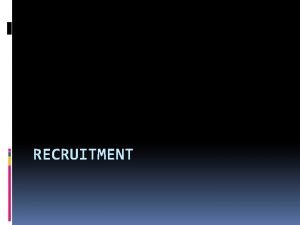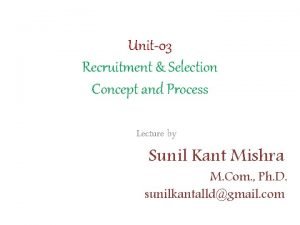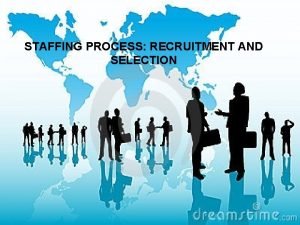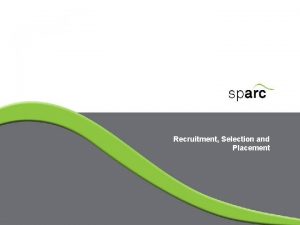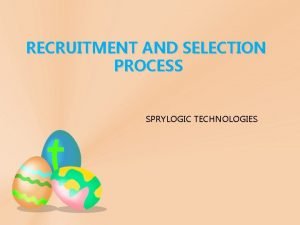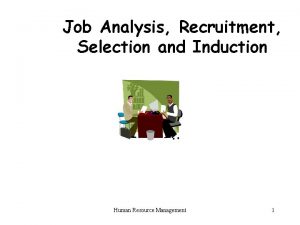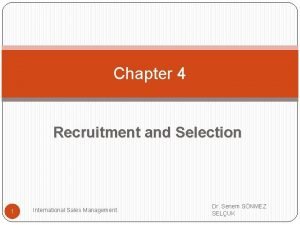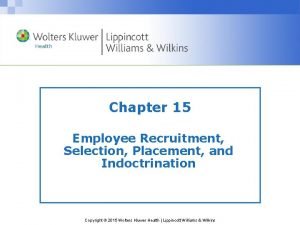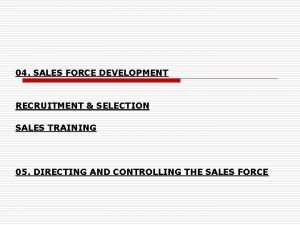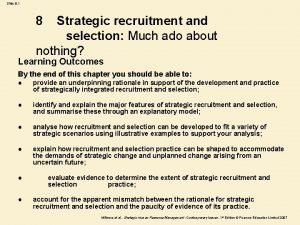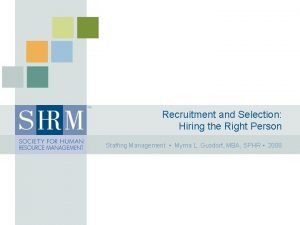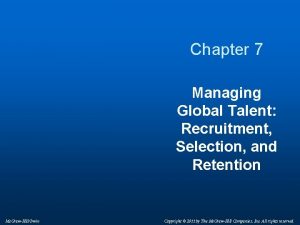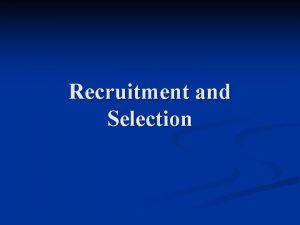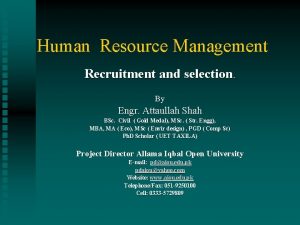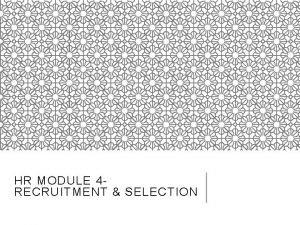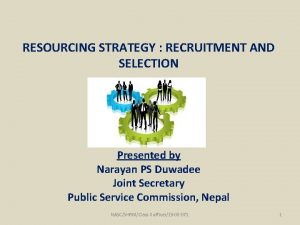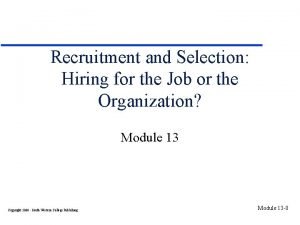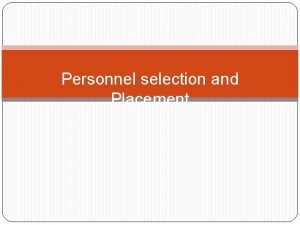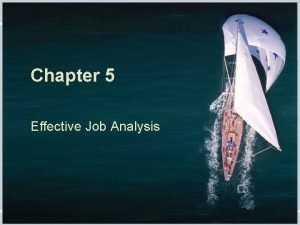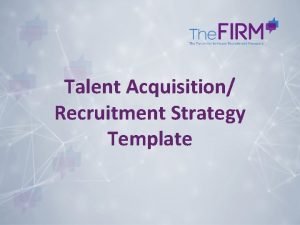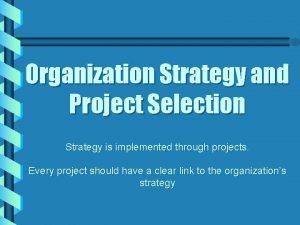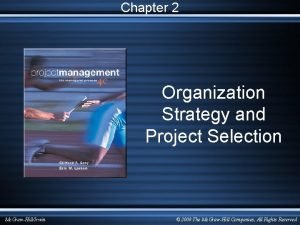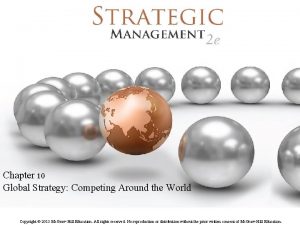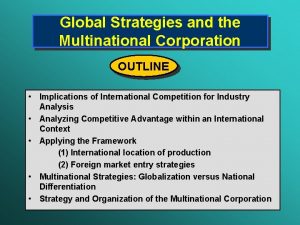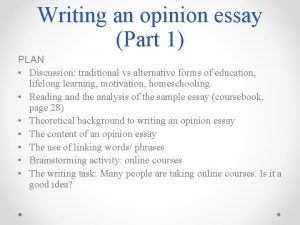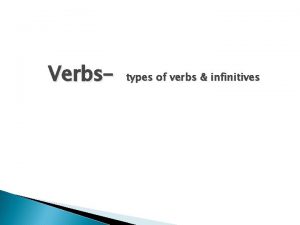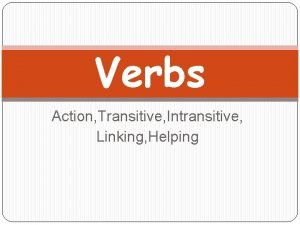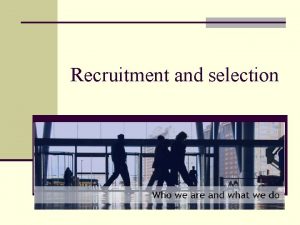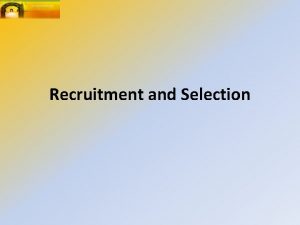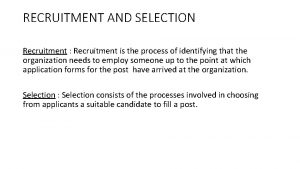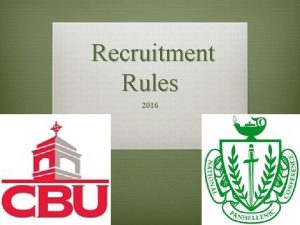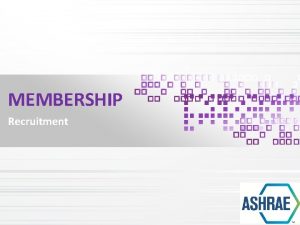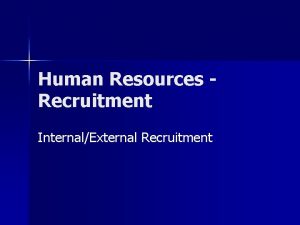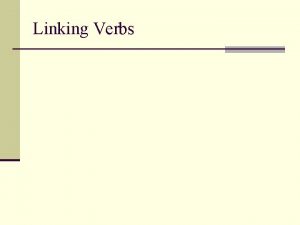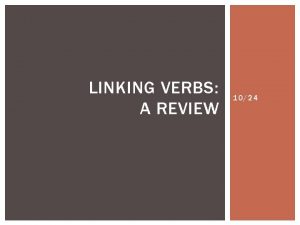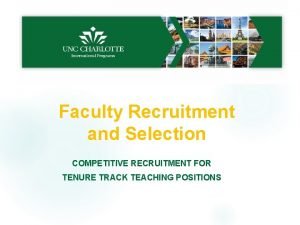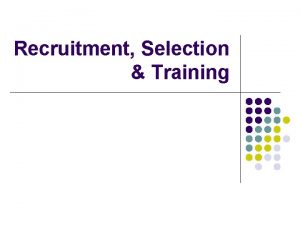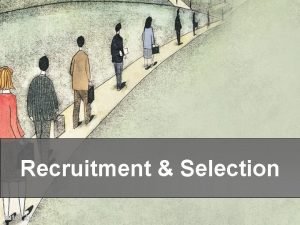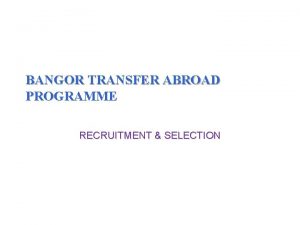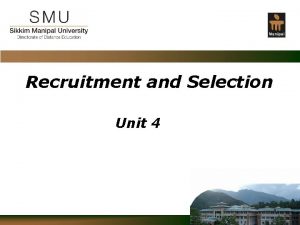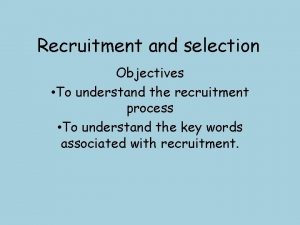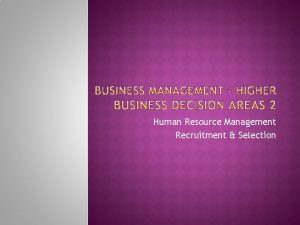HR MODULE 4 RECRUITMENT SELECTION LINKING STRATEGY TO


























































- Slides: 58

HR MODULE 4 RECRUITMENT & SELECTION

LINKING STRATEGY TO PLANS Diversify? Integrate vertically Expand geographically? On what basis should we compete Employers’ Strategic Plans Functional Plans Marketing & Sales Plans Manpower Forecasts Production Plans T&D Plans Recruitment & Selection Plans Financial Plans Compensation Plans HR Plans Employee Relations Plan

HR PLANNING PROCESS External Environment Scan Internal Environment Scan Demand Forecast Supply Forecast HR Program Implementation Evaluation & Audit Surplus Shortage

HR PROGRAMS : ALTERNATIVES TO DEAL WITH EMPLOYEE SHORTAGES

Recruitment “Recruitment is an art of discovering and procuring potential applicants for actual and anticipated vacancies”. Recruitment follows HRP ALL RIGHTS RESERVED

Objectives of Recruitment 1. 2. 3. 4. 5. 6. 7. 8. Determine the present and future requirements of the organisation. Increase the pool of job candidates at minimum cost. Reduce the number of underqualified or overqualified job applicants. Reduce the probability of the recruits leaving the organisation after a short period of time. Compliance of legal and social obligations on the composition of its workforce. Identify potentially appropriate job applicants. Increase organisational and individual effectiveness in the short term and long term. Evaluate the effectiveness of various recruiting techniques and sources for all types of job applicants. HUMAN RESOURCE MANAGEMENT, 5 E 6

Factors influencing recruitment External Forces • Supply and demand • Unemployment rate • Labour market • Political-legal • Sons of soil • Image Recruitment Internal Forces • Recruitment Policy • HRP • Size of the firm • Cost • Growth and expansion Plans 7

Factors affecting Recruitment • Size. Large organizations indulge in continuous recruitment • Employment conditions in the community plays a potential factor • Geographical factors and conditions play an important role • Organizational policies like promotions from within attract the employees • Compensation and benefit packages influence and attract the employees • Growing and expanding organizations attract employees ALL RIGHTS RESERVED

Constraints and Challenges in the recruitment process • Perceived image of the organization • Attractiveness of the job • Organizational policies • Legislation/Governmental policies • Costs of recruitment ALL RIGHTS RESERVED

Recruitment policy : 1. Identify the public policy on hiring and employment relationship 2. Provide maximum employment security 3. Encourage employees with continuing development of talent and skills 4. Assure fairness to the employees 5. Provide employment to physically handicapped or minority community as stipulated 6. Assure organization’s interest in his goals and employment objectives. ALL RIGHTS RESERVED

Recruitment Process Personnel Planning Job Vacancies Job Analysis Employee Requisition Recruitment Planning • Numbers • Type Searching Activation “Selling” • Message • Media Strategy Development • Where • How • When Applicant Population Applicant Pool Screening Potentia l Hires To Selection Evaluation and Control 11

Sources of Recruitment Professional or Trade Associations Advertisements Employment Exchanges Present Employees Consultants Contractors Former Employees Displaced Persons External Sources Walk -ins and Write-ins Employees Referrals Radio and Television Previous Applicants Recruitment Internal Sources Campus Recruitment Acquisitions and Mergers Competitors E-Recruiting 12

Recruitment strategy 1. Employer Branding a. Employee Value Proposition. b. Talent Focus 2. Publicity a. Flexible work environment b. Organization’s support for innovation c. Promotional opportunities and prospects to learn and grow. d. How performance is recognized and rewarded.

Recruitment strategy 3. Reinvigorate traditional recruitment methods. a. Creative advertising. AIDA principle b. High impact Employee/Customer Referral Program c. Spice up the Website. 4. Invest in innovative recruitment methods a. E recruitment b. Job Fairs c. Target Sourcing d. Recruitment Benchmarking

Methods of Recruiting Most organizations must use both internal and external sources to generate sufficient applicants When there is an inadequate supply within the organization, it must seek external candidates The choice of a recruiting method can make all the difference in the success of the recruiting effort

Internal sourcing Merits Demerits Economical: Cost minimal. No expenses incurred on advertising. Suitable: Right candidates for right jobs. Reliable: Known devils better than unknown ones. Limited Choice: Organization forced to select from a limited pool. Inbreeding: Discourages entry of talented people. Inefficiency: Seniority based promotions can encourage inefficiency and indifferent performance. Bone of contention: Infighting. Premium positions may end up on a bitter note. Satisfying: Motivates employees.

External Sourcing Merits Demerits Wide Choice: Candidates with required qualifications can be picked up. Injection of fresh blood: People with special skills and knowledge could be hired. Motivational force: Fires up internal candidate to work harder and leads to positive competition. Long Term benefits: Organization would gain momentum and change. Expensive: Hiring costs could go up. Time consuming: Time to advertise, screen, test and select suitable candidate. Demotivating: Discourages existing employees. Uncertainty: No guarantee that suitable candidates will be found

Internal Recruiting : Job posting ◦ Skills inventories can be used to identify internal applicants for job vacancies ◦ It is hard to identify everyone who might be interested in the opening, so firms use job posting and bidding � Today, postings are computerized and easily accessible to employees via the company’s intranet � Software allows employees to match an available job with their skills and experience � It may also highlight where gaps exist

Internal Recruiting: Moonlighting/Employee Referrals Ideal when there is: �A short-term shortage �No great amount of additional work Workers can be enticed to take a “second” job with bonuses Organizations sometimes frame moonlighting policies

External Recruiting Walk-ins ◦ Media advertising ◦ E-recruiting ◦ Employment agencies ◦ Executive search firms ◦ Special-events recruiting ◦ Internships

Media Advertising 1. Newspapers 2. Trade/professional publications 3. Billboards 4. Metro and bus cards 5. Radio 6. Telephone 7. Television

E-recruiting 30, 000 websites devoted to job posting activities. Globally 71 percent of all job listings on a handful of the “big boards” Monster. com, Career. Builder. com, Hot. Jobs. com, Jobsearch. org Over 96 percent of all U. S. companies now use the Internet for recruitment activities

E-recruiting 1. Relatively inexpensive 2. Provides immediate access to thousands of prospective applicants 3. Allows searches over broad geographic and company postings 4. Some online services, like Career. Path. com, catalog traditional newspaper recruiting ads 5. Specialized sites focus on particular fields or areas Having a human resources Web page is an effective addition to an overall recruitment strategy

Employment Agencies/Executive Search Executive search firms: Focus on higher-level managerial positions Are on Retainer Charge higher fees Employment agencies: Deal primarily with middle-level management and below Are paid on contingencies. (only when they have provided a new hire )

Special Events Recruiting 1. Open houses 2. Scheduled visits to headquarters 3. Informative literature 4. Speeches 5. Job fairs

Special Events Recruiting Job fairs: ◦ Can reduce recruiting costs by up to 80% ◦ Held on holidays or weekends to reach college students and the currently employed ◦ Useful for smaller, less well known employers ◦ Appeal to job seekers who wish to locate in a particular area and those wanting to minimize travel and interview time

Summer Internships ◦ Allows organizations to get specific projects done ◦ Exposes organizations to talented, potential employees who may become “recruiters” at school ◦ Provides trial-run employment ◦ Can attract the best people where there are labor shortages ◦ Can improve diversity

Realistic Job Previews Recruitment is more effective when realistic job previews (RJPs) are used Pertinent information about the job is given, without distortion or exaggeration Most jobs have unattractive features; the RJP presents the full picture

Realistic Job Previews Studies indicate that: ◦ Newly hired employees who received RJPs have a higher rate of job survival ◦ Employees hired after RJPs have higher satisfaction ◦ RJPs can set the job expectations at realistic levels ◦ RJPs do not reduce the flow of capable applicants

Recruitment Sources Effectiveness Miyake Studies Average Employee Turnover: 1. Candidates who came in through to Advertising- 51% 2. Spontaneous Applicants-37% 3. Candidates came in through Employee Referrals-30%

Alternatives to Recruitment Overtime Organizations avoid the cost of recruiting and having additional employees Employees earn additional income Potential problems include fatigue, higher accident rates, and increased absenteeism Continuous overtime often results in higher labor costs and reduced productivity

Alternatives to Recruitment Outsourcing Sometimes called “staff sourcing” Involves paying a fee to a leasing company or professional employer organization (PEO) that handles payroll, benefits, and routine HRM functions Especially attractive to small and midsize firms that can’t afford a fullservice HR department

Alternatives to Recruitment Temporary Employment One of the most noticeable effects of the downsizing epidemic and labor shortages of the past two decades “Just-in-time” employees staff all types of jobs (professional, technical, and executive positions)

RECRUITMENT METRICS: RECRUITMENT YIELD PYRAMID Offer Acceptance 20 Offers/Acceptance (3: 2) Job Offer 30 Invited for Final Interview Invited to Screening Interview 40 200 Interview/Offers (4: 3) Screening/Invites (5: 1) Contacts/Screens (10: 1) Initial Contacts 2000 34

RECRUITMENT METRICS COST TIME Cost Per Hire= Recruiting cost Time to Fill= On the job performance Number of days appraisal between the date the position was approved and the date the employee started working Number of positions Staffing Efficiency Ratio= Total Recruiting cost Total compensation of those recruited Time Ratio= Actual time to start Contracted time to start QUALITY New Hire Quality= (PR+HP+HR)/N PR=Average Job performance ratings HP=% of new hire promoted within a year HR=% of new hires retained after a year. N = Number of indicators used SATISFACTION Hiring Manager Satisfaction

RECRUITMENT METRIC New Hire loss metric Lost in 2014 Lost in 2013 Lost in 2012 Employees hired Y% in 2014 Employees hired V% in 2013 U% Employees hired S% in 2012 R% Q%

Recruitment Metric Salaries for recruiters. Management and professional time spent on preparing job description, job specifications, advertisements, agency liaison, and so forth. Cost of advertisements or other recruitment methods, that is, agency fees. Cost of producing supporting literature. Recruitment overheads and administrative expenses. Costs of overtime and outsourcing while the vacancies remain unfilled. Cost of recruiting suitable candidates for the selection process. 37

SELECTION Selection is the process of making a “hire” or “no hire” decision regarding each applicant for a job. The process typically involves determining the characteristics required for effective job performance and then measuring applicants on those characteristics. The characteristics required for effective job performance are typically based on a job analysis.

Overview of the selection process o. Assess job tasks and organizational context o. Choose valid predictors to assess o. Design a selection process that allows Organization & applicant to make a decision o. Synthesize information and make selection

Selection Process Employment Final decision Reference Check Medical Examination Final interview Group Discussion Written examination Application form

TYPICAL SELECTION METHODS 1. Application Blanks and Resumes 2. Physical Ability Tests 3. Interviews 4. Psychometric Tests 5. Work Samples 6. Reference and Background Checks 7. Assessment Centres 8. Medical Testing

APPLICATION BLANK: A FORMAT TO WRITE IN INDIVIDUAL DETAILS Purpose: To aid selection of candidates for interview To provide framework on which the interview can be built To form the basis of ‘future vacancies’ file To assist in the image building of the organization

TYPES OF INTERVIEWS Structured ● Unstructured ● Mixed ● Behavioural ● Stressful ●

Structured Interview The structured interview is based directly on a thorough job analysis. It applies a series of job-related questions with predetermined expected answers consistently across all interviews for a particular job.

Types Of Employment Interview 1 1 -Candidate 2 -Interviewer 2 One to one 1 2 1 2 Sequential Interview Panel Interview 1 2

Interview Errors Similar to me Effect Expectancy Effect Leniency and Harshness effect Contrast effect Interview First impressions Stereotyping Halo and Horns Effect Negative Information Bias

GUIDELINES FOR EFFECTIVE INTERVIEWS Give raters specific criteria and scoring key to evaluate responses Use panel interviews for efficiency and reliability Train interviewers Minimize bias, first impressions Ensure job-relatedness and consistency Provide frame-of-reference training

INTERVIEW EFFECTIVENESS Interviews are more likely to accurately predict job performance when Interview format is structured , and standardized. There are two formats which are more effective than others based on research: 1. Situational Interviewing 2. Behaviour based Interviewing. Situational Interviewing is where candidates are asked situation specific questions relating to how they would do the job, and are examined on their hypothetical performance. Answers are scored by specialists and interpreted according to a predetermined set of criteria

BEHAVIOURAL EVENT INTERVIEWS Behaviour Event Interview focuses on the candidate’s actual behaviour on the assumption that past behaviour is the best predictor of future behaviour. is a competency based assessment method that uses customized questions to assess leadership competencies. Candidates will be asked to recall events when they demonstrated a particular competency.

Using tests for selection Major types of tests used by employers Basic skills tests (45%) Drug tests (47%) Psychological tests (33%) Use of testing Increasingly being used as specific job skills and work demands increase Screen out undesirable employees Reduce turnover by personality profiling Source of tests Test publishers

Use of tests A organization must be able to prove: That its tests are related to success or failure on the job (validity) That its tests don’t unfairly discriminate against minority or non minority subgroups

Basic testing concepts Reliability The consistency of scores over time Test validity The accuracy with which a test, interview, and so on measures what it purports to measure or fulfills the function it was designed to fill Does the test actually measure what we need for it to measure?

Sample picture card from Thematic Apperception Test How do you interpret this picture? Source: Harvard University Press. Used with permission. Figure 6– 1

Other tests Interest inventories Personal development and selection devices that compare the person’s current interests with those of others now in various occupations so as to determine the preferred occupation for the individual Achievement tests Test that measure what a person has already learned—“job knowledge” in areas like accounting, marketing, or personnel

Work samples and simulations Work sampling technique A testing method based on measuring an applicant’s performance on actual basic job tasks Management assessment center A simulation in which management candidates are asked to perform realistic tasks in hypothetical situations and are scored on their performance

Reference checks Sources of information for background checks: Former employers Current supervisors Commercial credit rating companies Written references

Assessment Centres Assessment centres are designed to yield information that can be used to make decisions concerning suitability for a job. They provide a fuller picture by combining a range of techniques. General methods used include group discussions, role plays and simulations, interviews and tests. Candidates attending an assessment centre will be observed by assessors who should be trained to judge candidates’ performance against criteria contained within the competency framework.

Selection Process Metrics Validity Reliability Cost Ease of administration Applicant acceptance Putting more money into selection can reduce the amount that must be spent on training
 Dynamic linking vs static linking
Dynamic linking vs static linking Recruitment needs are of three types
Recruitment needs are of three types Recruitment is positive process
Recruitment is positive process Meaning of recruitment and selection
Meaning of recruitment and selection Recruitment selection and placement process
Recruitment selection and placement process Recruitment and selection meaning
Recruitment and selection meaning Distinguish between recruitment and selection
Distinguish between recruitment and selection Introduction on recruitment and selection
Introduction on recruitment and selection Recruitment and induction process
Recruitment and induction process Job analysis recruitment and selection
Job analysis recruitment and selection Exam questions on human resource development
Exam questions on human resource development Recruitment and selection of sales personnel
Recruitment and selection of sales personnel Recruitment selection and placement
Recruitment selection and placement Acmee model of sales training
Acmee model of sales training Strategic selection process
Strategic selection process Selection in staffing
Selection in staffing Global recruitment selection
Global recruitment selection Definition of recruitment and selection
Definition of recruitment and selection New trends in recruitment and selection
New trends in recruitment and selection Selection in human resource management
Selection in human resource management Recruitment and selection definition
Recruitment and selection definition Factors influencing recruitment and selection
Factors influencing recruitment and selection Components of employee resourcing strategy
Components of employee resourcing strategy Difference between hiring and recruitment
Difference between hiring and recruitment Personnel selection definition
Personnel selection definition Linking organizational strategy to hr planning
Linking organizational strategy to hr planning Recruitment strategy document
Recruitment strategy document C device module module 1
C device module module 1 Balancing selection vs stabilizing selection
Balancing selection vs stabilizing selection Similarities
Similarities K selected
K selected Natural selection vs artificial selection
Natural selection vs artificial selection Difference between continuous and discontinuous variation
Difference between continuous and discontinuous variation Disruptive selection.
Disruptive selection. K selection r selection
K selection r selection Natural selection vs artificial selection
Natural selection vs artificial selection Two way selection and multiway selection in c
Two way selection and multiway selection in c Two way selection and multiway selection in c
Two way selection and multiway selection in c Mass selection and pure line selection
Mass selection and pure line selection Pricing strategy module
Pricing strategy module Strategy is implemented through projects
Strategy is implemented through projects Selection project mc
Selection project mc Business strategy vs corporate strategy
Business strategy vs corporate strategy Transnational strategy vs global strategy
Transnational strategy vs global strategy Chase
Chase Multidomestic company
Multidomestic company Aligning hr strategy with business strategy
Aligning hr strategy with business strategy Integration responsiveness grid
Integration responsiveness grid The managerial process of crafting and executing strategy
The managerial process of crafting and executing strategy Strategy formulation vs strategy implementation
Strategy formulation vs strategy implementation Top-down listening strategy is a listener-based strategy.
Top-down listening strategy is a listener-based strategy. Strategic management chapter 7
Strategic management chapter 7 Multinational strategy vs global strategy
Multinational strategy vs global strategy Formal opinion essay
Formal opinion essay Linking vowel to vowel
Linking vowel to vowel Site:slidetodoc.com
Site:slidetodoc.com Lesson 5 verbs action (transitive/intransitive) answer key
Lesson 5 verbs action (transitive/intransitive) answer key Action linking helping verbs
Action linking helping verbs Is were a linking verb
Is were a linking verb

